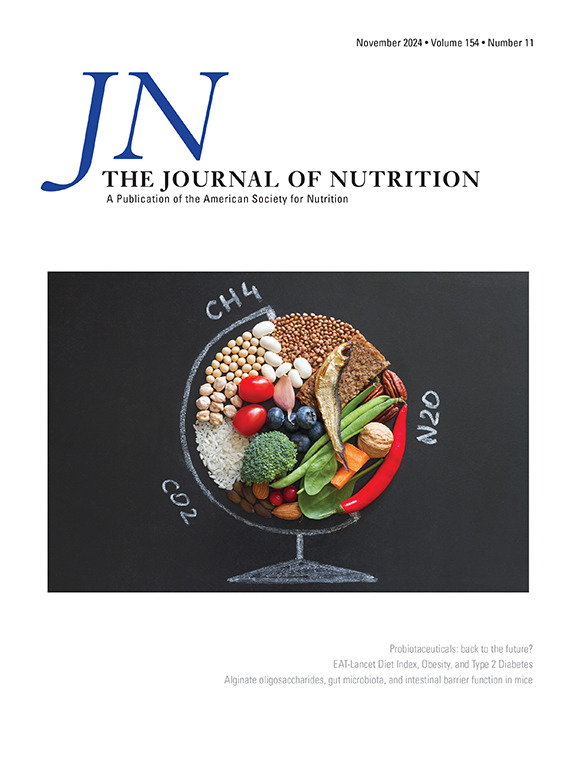高水碘水平与中国山东孕妇亚临床甲状腺功能减退、甲状腺结节和甲状腺肿的患病率有关。
IF 3.7
3区 医学
Q2 NUTRITION & DIETETICS
引用次数: 0
摘要
背景:孕期碘缺乏和碘过量都会对甲状腺造成损害。在没有碘强化的地区,水中碘浓度(WIC)与孕妇甲状腺疾病之间的关系需要进一步调查。目的:本研究的目的是评估居住在水碘含量高且无法获得碘盐的地区的孕妇的水碘水平与甲状腺疾病患病率之间的关系。方法:在山东省进行横断面调查。收集了水和尿液样本,并评估了碘含量。静脉血检测甲状腺激素及抗体水平。超声检查甲状腺大小,检查结节。结果:本研究共纳入1073名孕妇。线性回归分析显示,随着WIC的升高,尿碘浓度也随之升高(β=0.5;P100 μg/L与SH、TN和甲状腺肿患病率相关(OR [SH]: 10.8;95% ci: 1.4, 84.0;或[tn]: 2.5;95% ci: 1.1, 5.6;OR[甲状腺肿]:2.4;95% ci: 1.1, 5.6)。结论:WIC与孕妇甲状腺功能有关。WIC100 μg/L是SH、TN和甲状腺肿的危险因素。这些发现表明,中间WICs最有利于孕妇的甲状腺健康,评估局部WICs有助于改善孕产妇健康。本文章由计算机程序翻译,如有差异,请以英文原文为准。
High Water Iodine Concentrations Are Associated With the Prevalence of Subclinical Hypothyroidism, Thyroid Nodules, and Goiter Among Pregnant Women in Shandong, China
Background
Both iodine deficiency and iodine excess can harm the thyroid glands during pregnancy. In areas without iodine fortification, the relationship between the water iodine concentration (WIC) and thyroid disease in pregnant women requires further investigation.
Objectives
The aim of this study was to evaluate the relationship between WICs and the prevalence of thyroid disease in pregnant women residing in areas with high WICs without access to iodized salt.
Methods
A cross-sectional survey was conducted in Shandong Province. Water and urine samples were collected, and the iodine content was assessed. Venous blood samples were taken to measure thyroid hormones and antibodies. Ultrasound was used to assess thyroid size and detect nodules.
Results
A total of 1073 pregnant women were included in this study. As the WIC increased, the urinary iodine concentration also increased, according to linear regression analysis (β: 0.5; P < 0.001). The lowest prevalence of subclinical hypothyroidism (SH) and thyroid dysfunction (TD) was observed at a WIC of 10–40 μg/L, whereas the lowest prevalence of thyroid nodules (TNs) and goiter was seen at a WIC of 40–100 μg/L. Logistic regression analysis showed that WIC was significantly associated with thyroid diseases. WIC of <10 μg/L was associated with TD prevalence (OR: 1.8; 95% CI: 1.1, 3.1), and WIC of >100 μg/L was associated with SH, TN, and goiter prevalence (SH—OR: 10.8; 95% CI: 1.4, 84.0; TN—OR: 2.5; 95% CI: 1.1, 5.6; goiter—OR: 2.4; 95% CI: 1.1, 5.6).
Conclusions
WIC is associated with thyroid function among pregnant women. WIC of <10 μg/L is a risk factor for TD, whereas WIC of >100 μg/L is a risk factor for SH, TN, and goiter. These findings suggest that intermediate WICs are most conducive to thyroid health in pregnant women and that assessing local WICs could help improve maternal health.
求助全文
通过发布文献求助,成功后即可免费获取论文全文。
去求助
来源期刊

Journal of Nutrition
医学-营养学
CiteScore
7.60
自引率
4.80%
发文量
260
审稿时长
39 days
期刊介绍:
The Journal of Nutrition (JN/J Nutr) publishes peer-reviewed original research papers covering all aspects of experimental nutrition in humans and other animal species; special articles such as reviews and biographies of prominent nutrition scientists; and issues, opinions, and commentaries on controversial issues in nutrition. Supplements are frequently published to provide extended discussion of topics of special interest.
 求助内容:
求助内容: 应助结果提醒方式:
应助结果提醒方式:


